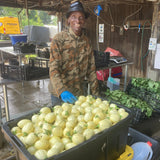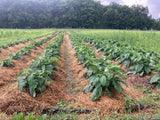Nya Nya Chungu (African Eggplant)
Solanum aethiopicum
Please note: this listing is for SEEDS, not fresh eggplants!
Nya Nya Chungu is an African eggplant popular in Congolese communities. If you eat it daily there are many medicinal benefits including reducing blood sugar. Cook Nya Nya Chungu with anything: it is great with meat, fish, and leafy greens! Nya Nya Chungu is often peeled, then halved or quartered before cooking. Nya Nya Chungu can be salted then eaten raw for health benefits.
This variety was grown for our catalog by Kandolo Makongo. Kandolo is an incubator and Congolese community farmer at Providence Farm Collective. A long time seed saver, Kandolo is selling Congolese specialty greens seeds and Nya Nya Chungu eggplant for the first time in 2024.
This is a type of white garden egg, gilo eggplant, or scarlet eggplant.
Days to maturity: 60 days after transplant
Seeds per pack: 50-60
Germination rate: 97 02/20/2025
Planting / harvesting notes
Nya Nya Chungu should be started indoors 4-6 weeks before transplanting. Transplant after the risk of frost. Begin harvesting fruits about 60 days after transplanting. Spacing 2 feet between plants and 2 feet between rows.
Seed keeping notes
Eggplants are generally self-pollinating, though we isolate different varieties of the same species by 300 feet, in hopes that flying insects will not cross pollinate them unexpectedly. Eggplant seeds are ripe when the fruits get far past their edible stage, and have turned another color, in this case orange. Cut the fruit, scrape out seeds (perhaps through a heavy-duty screen) into a vessel, add a little water (1-2" is probably plenty) to your seeds and pulp to keep them from drying out, and allow them to ferment away from direct sunlight. Fermentation is not necessary with eggplants, but it makes seed cleaning a bit easier. Ideally, you will stir the concoction every day for 3-5 days. In the end, add more water to fill the vessel, stir one final time, and allow the seeds to settle. Pour off the floating material and then strain the seeds through a strainer. Sometimes, you will need to add more water and pour off the floating material several times until the water is clear and you can see the seeds sunken at the bottom. Squeeze dry the strained seeds in a towel, and then lay out to dry on a labeled screen or paper product in a ventilated place away from direct sunlight for a week or two.











